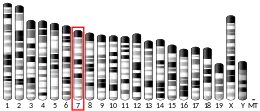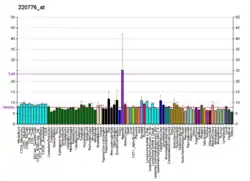| KCNJ14 | |||||||||||||||||||||||||||||||||||||||||||||||||||
|---|---|---|---|---|---|---|---|---|---|---|---|---|---|---|---|---|---|---|---|---|---|---|---|---|---|---|---|---|---|---|---|---|---|---|---|---|---|---|---|---|---|---|---|---|---|---|---|---|---|---|---|
| Identifiers | |||||||||||||||||||||||||||||||||||||||||||||||||||
| Aliases | KCNJ14, IRK4, KIR2.4, potassium voltage-gated channel subfamily J member 14, potassium inwardly rectifying channel subfamily J member 14 | ||||||||||||||||||||||||||||||||||||||||||||||||||
| External IDs | OMIM: 603953 MGI: 2384820 HomoloGene: 27086 GeneCards: KCNJ14 | ||||||||||||||||||||||||||||||||||||||||||||||||||
| |||||||||||||||||||||||||||||||||||||||||||||||||||
| |||||||||||||||||||||||||||||||||||||||||||||||||||
| |||||||||||||||||||||||||||||||||||||||||||||||||||
| |||||||||||||||||||||||||||||||||||||||||||||||||||
| |||||||||||||||||||||||||||||||||||||||||||||||||||
| Wikidata | |||||||||||||||||||||||||||||||||||||||||||||||||||
| |||||||||||||||||||||||||||||||||||||||||||||||||||
Potassium inwardly-rectifying channel, subfamily J, member 14 (KCNJ14), also known as Kir2.4, is a human gene.[5]
Potassium channels are present in most mammalian cells, where they participate in a wide range of physiologic responses. The protein encoded by this gene is an integral membrane protein and inward-rectifier type potassium channel, and probably has a role in controlling the excitability of motor neurons. Two transcript variants encoding the same protein have been found for this gene.[5]
See also
References
- 1 2 3 GRCh38: Ensembl release 89: ENSG00000182324 - Ensembl, May 2017
- 1 2 3 GRCm38: Ensembl release 89: ENSMUSG00000058743 - Ensembl, May 2017
- ↑ "Human PubMed Reference:". National Center for Biotechnology Information, U.S. National Library of Medicine.
- ↑ "Mouse PubMed Reference:". National Center for Biotechnology Information, U.S. National Library of Medicine.
- 1 2 "Entrez Gene: KCNJ14 potassium inwardly-rectifying channel, subfamily J, member 14".
Further reading
- Kubo Y, Adelman JP, Clapham DE, et al. (2006). "International Union of Pharmacology. LIV. Nomenclature and molecular relationships of inwardly rectifying potassium channels". Pharmacol. Rev. 57 (4): 509–26. doi:10.1124/pr.57.4.11. PMID 16382105. S2CID 11588492.
- Bonaldo MF, Lennon G, Soares MB (1997). "Normalization and subtraction: two approaches to facilitate gene discovery". Genome Res. 6 (9): 791–806. doi:10.1101/gr.6.9.791. PMID 8889548.
- Töpert C, Döring F, Wischmeyer E, et al. (1998). "Kir2.4: a novel K+ inward rectifier channel associated with motoneurons of cranial nerve nuclei". J. Neurosci. 18 (11): 4096–105. doi:10.1523/JNEUROSCI.18-11-04096.1998. PMC 6792806. PMID 9592090.
- Töpert C, Döring F, Derst C, et al. (2000). "Cloning, structure and assignment to chromosome 19q13 of the human Kir2.4 inwardly rectifying potassium channel gene (KCNJ14)". Mamm. Genome. 11 (3): 247–9. doi:10.1007/s003350010047. hdl:11858/00-001M-0000-0012-F99D-B. PMID 10723734. S2CID 7544438.
- Hughes BA, Kumar G, Yuan Y, et al. (2000). "Cloning and functional expression of human retinal kir2.4, a pH-sensitive inwardly rectifying K(+) channel". Am. J. Physiol., Cell Physiol. 279 (3): C771–84. doi:10.1152/ajpcell.2000.279.3.C771. PMID 10942728.
- Nagase T, Kikuno R, Ohara O (2002). "Prediction of the coding sequences of unidentified human genes. XXII. The complete sequences of 50 new cDNA clones which code for large proteins". DNA Res. 8 (6): 319–27. doi:10.1093/dnares/8.6.319. PMID 11853319.
- Strausberg RL, Feingold EA, Grouse LH, et al. (2003). "Generation and initial analysis of more than 15,000 full-length human and mouse cDNA sequences". Proc. Natl. Acad. Sci. U.S.A. 99 (26): 16899–903. Bibcode:2002PNAS...9916899M. doi:10.1073/pnas.242603899. PMC 139241. PMID 12477932.
- Gerhard DS, Wagner L, Feingold EA, et al. (2004). "The status, quality, and expansion of the NIH full-length cDNA project: the Mammalian Gene Collection (MGC)". Genome Res. 14 (10B): 2121–7. doi:10.1101/gr.2596504. PMC 528928. PMID 15489334.
- Fang Y, Schram G, Romanenko VG, et al. (2005). "Functional expression of Kir2.x in human aortic endothelial cells: the dominant role of Kir2.2". Am. J. Physiol., Cell Physiol. 289 (5): C1134–44. doi:10.1152/ajpcell.00077.2005. PMID 15958527. S2CID 11840480.
- Tennant BP, Cui Y, Tinker A, Clapp LH (2007). "Functional expression of inward rectifier potassium channels in cultured human pulmonary smooth muscle cells: evidence for a major role of Kir2.4 subunits". J. Membr. Biol. 213 (1): 19–29. doi:10.1007/s00232-006-0037-y. PMC 1973150. PMID 17347781.
External links
- KCNJ14+protein,+human at the U.S. National Library of Medicine Medical Subject Headings (MeSH)
This article incorporates text from the United States National Library of Medicine, which is in the public domain.
This article is issued from Wikipedia. The text is licensed under Creative Commons - Attribution - Sharealike. Additional terms may apply for the media files.




